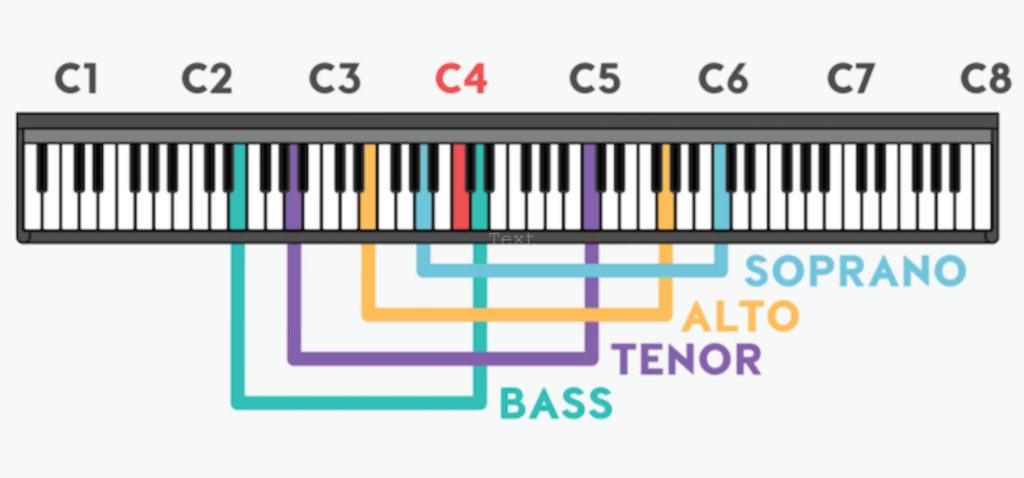Before we figure out how to find your vocal range, there are a few things about it that we need to discuss. Voices are delightfully unique because they are a part of your anatomy. That means that your vocal range, among other things, might not necessarily fit into a neat box.
Why then, would we need to know our range? Do you ever wonder why famous singers all know their ranges? It’s not that the label changes their abilities or makes them better singers. It’s not even about finding the absolute lowest and highest notes they can sing. It’s actually about knowing where they can comfortably sing, which provides them with an understanding of their strengths and weaknesses.
Smart singers play to their strengths rather than trying to conform to fit a mold. The best vocalists are the ones who do incredible things within their unique range. Once they start reaching out of that, it’s easy to get lost in setting standards rather than creating something lovely.
Watch Brett Manning Demonstrate a 5 Octave Vocal Range!
More Notes = More Money?
A quick story for y’all. Some of you may have read this in an earlier blog.
A couple of decades ago, I made friends with this rock singer that I always saw playing basketball at the YMCA. He knew of me and said he respected my abilities and the reputation I had as an effective vocal coach. But he eventually brought this up to me after a game (I think we won…or I’d like to think so 😉)
He told me that he never needed a vocal coach, nor had he ever used one.
I simply said something like… “That’s cool.”
Then he went on to tell my about his record deal and how they like his voice just like it is and didn’t wanna change anything.
Again, I smiled and said, “Cool.” Then I waited…
Out of the blue, I asked him “Dude, do you think you could use more high notes?” He immediately replied:
“DUH…THAT’S LIKE ASKING ME IF I NEED MORE MONEY!”
I offered him a free 15 minutes (it was Saturday and I had some ‘free’ time…pun intended). He followed me to my house and I began a series of my systematic exercises—that many of you have been doing for years and years—and he went up and extra 1/2 octave!
HE FREAKED!
Immediately, he asked me if he could pay for a full hour right then and there. I obliged, “Of course!” and we added nearly full octave of high notes and a few more low notes as well. Then, he urgently called his producer and told him to hold off on production because he wanted to RAISE THE KEYS! He suddenly had all this hidden voice and he wanted, perhaps needed, to explore all of his new potential.
Oh yeah! One more thing. The higher range was EASIER than his former high notes. Dang, I love my job!
Your current range is NOT final. Read that again…slowly! Now believe it! This is why major and indie labels alike are sending singers to my Nashville studio for effective training with my talented coaches and myself….to find those high notes. Those “money” notes!
Remember this…
Our goals as musicians are to learn, to better ourselves, and to enrich the world through our music. You don’t have to have a five-octave range like Mariah Carey (or me~blush) to be passionate about what you do. However, you do need to understand your voice and its capabilities
What Exactly is a Vocal Range?

Vocal range is the lowest note to the highest note a singer can produce with a consistent and recognizable pitch.
As I mentioned earlier, there are exercises you can do to increase your vocal range, but when first measuring, don’t strain your voice to get that extra high note. Your range should be where you can sing comfortably. We’ll talk more in-depth about how to measure your vocal range a little further down.
There are many incredible vocal ranges out there. Vocal range heroes in our contemporary music are mind-blowing. Freddie Mercury’s vocal range stretched well over three octaves. Similarly, Ariana Grande’s vocal range is four octaves. And Mariah Carey’s—as mentioned earlier—has a vocal range spanning five octaves. These ranges, while incredible, are abnormal.
Some other icons of vocal range include: Vitas (Opera 2), Dimash (SOS, also Opera 2) and the opera aria “Queen of the night” as well.
What is the Average Vocal Range for a Man?
An average, full-grown man will usually have a comfortable range of one and a half or two octaves. Typically, this falls somewhere in the range of C2-C5 depending on the man’s voice type. Bass is the lowest of the vocal ranges, while the tenor’s vocal range is the highest male voice type, with baritone settled comfortably between them.
I say “full-grown” because the voice changes quite a bit, especially before, during, and just after puberty. The voice often stabilizes around twenty to twenty-four years of age, but it can continue to change through a person’s twenties and into their early thirties. In fact, the human voice typically reaches full maturity in the early to mid forties.
Male voices typically deepen with age, but sometimes the singing voice can atrophy and the voice can settle into a higher speech level. In this case, the lower range can dissipate. But vocal fry is a coordination used to restore your lowest and highest notes!
(See my blog on vocal fry to learn my secrets to finding your lowest note using one simple exercise.)
What is the Average Vocal Range for a Woman?
A full-grown woman can commonly reach two to three octaves somewhere in the midst of E3-C6. Voice types for women include alto, mezzo-soprano, and soprano. Altos are female voices that reach the very low notes, while sopranos cover the very high notes. The mezzo-soprano range sits comfortably between the two.
You may hear “alto” and “contralto” used interchangeably in the music world. They are very similar, but contralto actually refers to a female voice a few steps below alto. Alto was the common term until contralto started giving it some competition. The contralto’s range falls between the mezzo and the tenor. They are the lowest of the female vocal ranges. There are very few situations where a man can join the contralto part. This part can usually sing down to the F below middle C up to at least the second E above middle C (E5).
Why Should You Find Your Vocal Range?
Knowing your vocal range is important whether you’re planning on pursuing vocal training or not. Knowing your range can help you prevent damage to your voice that comes from strain. Certain vocal exercises can help you increase your range, but vocal health is very important. Increasing your range should almost always be discovered while taking voice lessons or using an effective course, like my ground-breaking course, “Range Builder.”
Protect Your Vocal Cords
Straining the voice is one of the biggest problems for singers. Often, it’s an issue of bad technique; utilizing the wrong muscles. But it can also be just trying to sing notes that are, quite frankly, out of reach. If you’ve not been taught, there’s no reason to be stretching (pushing or straining) your voice beyond its capabilities. As a matter of fact, this can damage your vocal cords.
Every singer is responsible for caring for their “instrument,” the voice. Beginner singers, who are just now discovering their range, should be working on songs that are in their comfort range, while developing tone quality, endurance, style, and so on.
It is essential to practice good vocal health habits. Always warm up before practicing or performing. When you do this, you are mentally preparing for singing, but you are also physically warming up and coordinating your vocal cords. A great singing technique taught by a well-trained singing teacher can ensure that you utilize the same process that pro singers have used to prepare their voices for decades.
Another way to keep your voice healthy is to take vocal breaks throughout the day. Spend an hour or so not singing and always avoid speaking harshly. Keep a humidifier in your room. This is especially important if you live in a dry climate. Maintain a healthy diet, including plenty of water and no smoking, even secondhand smoke.
The list goes on. Can you imagine why? It’s because vocal health is so important and often ignored.
You Want It To Sound Good
Here is another plain, but somewhat hard-to-swallow fact. Singing outside of your range not only damages your voice, it just doesn’t have the tone you should be striving for. Save yourself the throat (and ear!) ache and refrain from this kind of strain.
In fact, I remember watching American Idol about a decade ago (I don’t often watch these shows except when I have a student/client competing on the show), when a girl started wailing out the super high notes that were actually in her comfortable range! It was “RESPECT” by Aretha Franklin. Unfortunately, she didn’t sound comfortable singing in this range. The quality of notes sung is more impressive than your highest note. Be sensible to the song…always!
DO NOT FALL INTO THIS TRAP: Just because you can sing notes in a higher range or the lowest notes that anyone has heard, doesn’t mean you automatically “HAVE” to show your full voice. But some feel like their starting note has to win over an audience. However, vocal types are different and not everyone can sound great singing in Mariah Carey’s vocal range. You need to find your vocal range! What is far more important is your own unique sound!!
What is a Vocal Range Test?
With a process that isn’t too complicated, you can quickly find out your range. We’ll take you through it step-by-step.
How To Find Your Vocal Range
Before you begin, decide on a vowel sound to sing each note with. “Ah,” as in father, tends to be quite common. The most important thing is that you’re consistent with it.
Find a guitar or another kind of instrument that revolves around pitches within your expected range. (A double bass, for example, probably won’t work, especially if you’re a woman.)
A piano is the best choice even if you’ve never played it in your life.
Play the Middle C
Begin in the middle of the piano on Middle C (AKA, C4). Match that pitch with your chosen vowel sound in preparation for your descent.
Mark the Low
From Middle C, travel down one note at a time, matching the pitch each time. Go until you reach the lowest recognizable pitch that you can sing without your voice cracking. Singing the low note with breathiness doesn’t count. It has to be a clear, sustainable pitch. Write it down so that you don’t forget what it was when you move on to the next step.
Mark the High
Begin again at Middle C and work your way up the piano to the highest pitch you can sing comfortably. Remember to retain the same vowel sound throughout the process. Write it down.
There you go! Now you know your natural range. Remember this…. you don’t have to be stuck here. You can easily add several notes if you learn the right technique.
How Can Your Vocal Range Help You?
Knowing your range will allow you to find your vocal type or classification. But… WARNING!!! Do not allow yourself to limit your singing voice. You can transcend these titles.
Understand that voices don’t fully mature until adulthood and you should never try to force your voice into one category or another because that can damage your voice.
There are six standard voice types used in Western music today. They are, from highest to lowest, soprano, mezzo-soprano, alto (contralto), tenor, baritone, and bass. The upper three are reserved for women while the lower three are reserved for men (with a few exceptions).
You may have seen music labeled with SATB. That is an indication of the parts being sung. This kind of music often files the six voice categories down into four parts which are soprano, alto, tenor, and bass. Just singing the tenor part doesn’t necessarily make you a tenor because the categories are broader than that.
How Can Knowing Your Vocal Range Benefit You?
Aside from being more familiar with your voice, there are many ways that knowing your range can help you in your singing career. It makes it easier to find music, for one.
Searching, “classical music for voice,” in Google gets you a multitude of responses, most of which won’t pertain to you. However, searching “classical music for the baritone voice,” will narrow down your options considerably and make them relevant to you as a singer.
It Helps To Find Trouble Spots In Your Voice
Most singers have some notes in their voice that they struggle to get as clear or easily as others. If you’re within your comfortable range, you know which notes are important to improve, and which can wait. Just assuming that you should be able to sing an E2 when it’s actually well outside your range won’t get you anywhere.
When you’re aware of where you’re supposed to be, you can progress much more quickly.
Speaking of progress…
Tool to Measure Progress
Knowing where you began is the only way to truly measure how far you’ve come. Your range allows you to track your progress in multiple ways.
You should never compare your voice to another. You are unique, set apart. You have your own vocal journey. It may take longer than others but that isn’t what’s important. Range, especially, is not to be used as a tool for comparison.
One more point about range: There’s always someone out there higher or lower, stronger, deeper, lighter, more breathy, more sweet, more rhythmic, more soulful, more distinct, more commercial and more ‘vibey’ than you… or myself. This should NOT discourage us. Music is far too transcendent to be narrowed to your ability.
However… your audience will have a wider range of emotions about you as a singer and musician if you utilize a wider range of notes. But… this isn’t the same as showing off. You give yourself to the song and you sing to make the song better!
Follow me here! @brett’s__imaginarium

Look Up Singers With Similar Vocal Ranges
When you know your range, you can look up professional singers with the same range and vocal type as you. Doing this can really inspire a struggling vocalist to push forward in terms of creativity, determination, and endurance.
Being a musician, especially for famous singers, is not for the faint of heart. Consider those who have gone before you, overcame struggles, and made names for themselves. Learning about their tragedies and triumphs, can be one of the biggest encouragements that the entertainment world has to offer.
Choose the Best Songs For Your Range
More specifically than the example I used earlier when you search for those artists with your range, you already have an abundance of music written for vocalists exactly like you! It’s very valuable to have these pieces because they help you discover your voice.

Finding Your Range: Head Voice vs Chest Voice
People often confuse the sounds of head voice and chest voice, but they have distinct differences in quality, range, sensation, and vocal cord structure.
The quality of chest voice tends to be pronounced and strong, similar to your speaking voice. Head voice, on the other hand, is a bit lighter. It’s similar to falsetto in women. Except falsetto is very airy and light. Head voice still has quite a bit of substance and allows a robust sound in the higher register.
The range of chest voice is lower notes, towards the middle or most comfortable range. Head voice travels above your vocal bridge (aka passagio), higher in your vocal range.
What I mean by sensation is where you feel the vibrations when using each of these voices. When singing from your chest, the vibrations are felt externally on your chest. Internally, the sound is primarily resonating (vibrating) against the roof of the mouth.
When singing with your head voice, you will feel the vibrations, your vocal tone in the nasal cavity, internally. Externally, you’ll feel this resonance or vibration in the top and back of your head as you ascend into the top of your voice.
The way your vocal cords coordinate is also different between each voice. When using head voice, your vocal cords are thinner, which is why it can’t have as much substance as when using chest voice. Chest voice uses your vocal cords’ full length and thickness, giving the vibrations lots of room and the tone a fuller sound.
Head voice is the highest register you can reach without breaking into the whistle register, which not everyone has.
You may have heard the term “mixed voice.” This is a method of singing that mixes your chest voice and your head voice, allowing you to comfortably switch between them. Singing in the mixed register can give the singer better control over their voice and the notes they’re reaching for.
An added benefit of mixed voice, is that you get the blend of 2 qualities—head and chest—which doubles your resonance qualities and your tonal diversity. I like to tell my singers that mix is “heavier than head voice and lighter than chest voice.”
Read up on my ground breaking course titled, “Mastering Mix,” to hear more about this necessary, elusive, and greatly sought after coordination.
Start Working On Your Vocal Range Now!
Finally, I offer you a challenge. Find your vocal range. Then increase it! It’s not uncommon for my talented coaches to add an octave to a singer’s highest note. Sometimes in the first few sessions. Famous singers almost ALL have a coach or a set of vocal exercises or warmups they use to prepare their voices for a gig or just to prepare to work on songs.
Join the tens of thousands of singers in over a 180 countries who’ve experience life changing vocal breakthroughs with the Singing Success methodology.
We can’t wait to hear you sing!
Book A Voice Lesson (Nashville & Online)
or call our booking coordinator at
615-866-1099.






